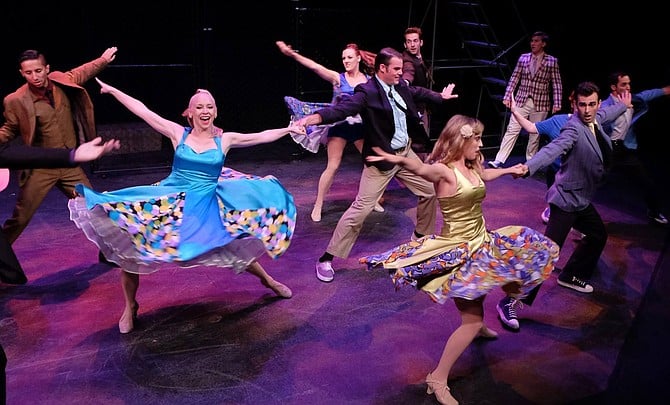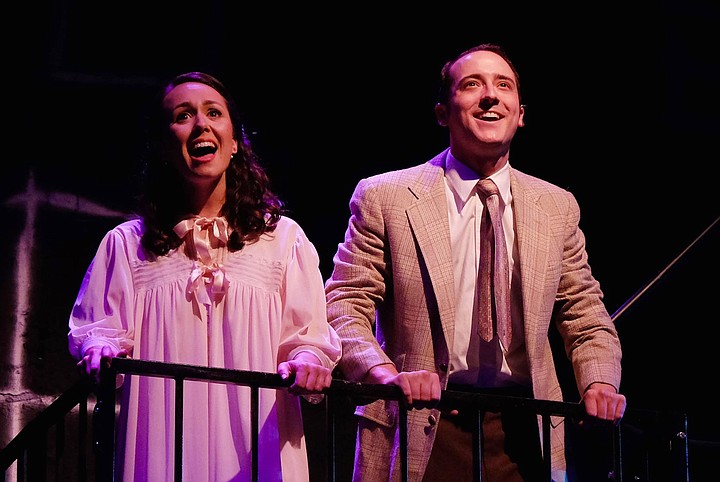 Facebook
Facebook
 X
X
 Instagram
Instagram
 TikTok
TikTok
 Youtube
Youtube

Musicals have iconic images: a Huey helicopter? Miss Saigon; white semi-mask? Phantom; Julie Andrews’ 360 on a green hill, dressed like a risqué Puritan? Sound of Music, the movie.
How about a chain-link fence and rusty iron fire escapes? Easy: Jets, Sharks, culture-biased lovers, and a “west side” story older than Shakespeare and as pertinent today.
In the last few years, Lamb’s Players Theatre’s become the site of smash hit summer musicals. Their West Side Story should continue that trend. It’s a blazer.
It starts with the choreography. In the famous opening sequence, no one says a word as rival New York gangs “rumble.” Master-choreographer Colleen Kollar Smith and fight choreographer Jordan Miller fling dancers all over the stage, throwing and dodging punches, leap-frogging into the fray.
As with Jerome Robbins’ original “ballet d’action,” Kollar Smith adds an element of danger: the fight’s staged, but played so in-close that someone could get hurt.
(One of the tragedies of West Side Story for me: it’s as if each dancer were two possibilities — the violent street fighter and the graceful artist they might have become.)

One of the hallmarks of Deborah Gilmour Smyth’s direction is a youthful vigor and innocence — faced with life and death consequences.
Kevin Hafso-Koppman’s engaging Tony and Olivia Hernandez’ outstanding Maria are just kids. They’ve seen enough of the world to be wary, but not enough to blunt their idealism. They really fall — nay, hurtle — into ardent, breathless, four-alarm love, convincingly.
The sense of threatened youth extends throughout. When Maria sings “I Feel Pretty,” it’s as if she and her girlfriends are giggling at a slumber party.
Some parts of the song are in Spanish. This choice may have come from the 2009 Broadway revival, which made changes to the original, as may the equally great move to turn Tony and Maria’s unforgettable “Somewhere” into a choral number. The cast sings in white outfits, stripped of labels and differences.
And what an eerie jolt: Tony and Maria face each other center-stage for the biggie. You hear “There’s…a…place for us,” only their lips don’t move. Look up: the character Anybodys is singing on the second tier of Mike Buckley’s Manhattan playground set. Then the cast joins in, and “Somewhere” becomes a rousing anthem a la “Climb Every Mountain” and “Let the Sunshine In.”
The set has something I don’t think I’ve seen before: Patrick Marion’s nine-person band’s on two levels, stage right, and provides strong support.
As does the sprinting/soaring cast, especially Patrick J. Duffy (Bernardo), Daniel Kermidas (a powerhouse as the uneasy Action), Jesse Abeel (Riff), Christopher Lesson (Officer Krupke), and Shaun Tuazon-Martin (Chino).
Lamb’s Players is renowned for ensemble shows. As Anita, Michelle Alves does an un-Lamb’s thing. She often plays front, winking or nodding to the audience as if they were in cahoots. Given Lamb’s approach, Alves’ asides stand out in a negative way. But then again, every other move she makes stands out in a positive one.


Musicals have iconic images: a Huey helicopter? Miss Saigon; white semi-mask? Phantom; Julie Andrews’ 360 on a green hill, dressed like a risqué Puritan? Sound of Music, the movie.
How about a chain-link fence and rusty iron fire escapes? Easy: Jets, Sharks, culture-biased lovers, and a “west side” story older than Shakespeare and as pertinent today.
In the last few years, Lamb’s Players Theatre’s become the site of smash hit summer musicals. Their West Side Story should continue that trend. It’s a blazer.
It starts with the choreography. In the famous opening sequence, no one says a word as rival New York gangs “rumble.” Master-choreographer Colleen Kollar Smith and fight choreographer Jordan Miller fling dancers all over the stage, throwing and dodging punches, leap-frogging into the fray.
As with Jerome Robbins’ original “ballet d’action,” Kollar Smith adds an element of danger: the fight’s staged, but played so in-close that someone could get hurt.
(One of the tragedies of West Side Story for me: it’s as if each dancer were two possibilities — the violent street fighter and the graceful artist they might have become.)

One of the hallmarks of Deborah Gilmour Smyth’s direction is a youthful vigor and innocence — faced with life and death consequences.
Kevin Hafso-Koppman’s engaging Tony and Olivia Hernandez’ outstanding Maria are just kids. They’ve seen enough of the world to be wary, but not enough to blunt their idealism. They really fall — nay, hurtle — into ardent, breathless, four-alarm love, convincingly.
The sense of threatened youth extends throughout. When Maria sings “I Feel Pretty,” it’s as if she and her girlfriends are giggling at a slumber party.
Some parts of the song are in Spanish. This choice may have come from the 2009 Broadway revival, which made changes to the original, as may the equally great move to turn Tony and Maria’s unforgettable “Somewhere” into a choral number. The cast sings in white outfits, stripped of labels and differences.
And what an eerie jolt: Tony and Maria face each other center-stage for the biggie. You hear “There’s…a…place for us,” only their lips don’t move. Look up: the character Anybodys is singing on the second tier of Mike Buckley’s Manhattan playground set. Then the cast joins in, and “Somewhere” becomes a rousing anthem a la “Climb Every Mountain” and “Let the Sunshine In.”
The set has something I don’t think I’ve seen before: Patrick Marion’s nine-person band’s on two levels, stage right, and provides strong support.
As does the sprinting/soaring cast, especially Patrick J. Duffy (Bernardo), Daniel Kermidas (a powerhouse as the uneasy Action), Jesse Abeel (Riff), Christopher Lesson (Officer Krupke), and Shaun Tuazon-Martin (Chino).
Lamb’s Players is renowned for ensemble shows. As Anita, Michelle Alves does an un-Lamb’s thing. She often plays front, winking or nodding to the audience as if they were in cahoots. Given Lamb’s approach, Alves’ asides stand out in a negative way. But then again, every other move she makes stands out in a positive one.
Comments